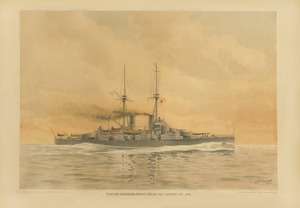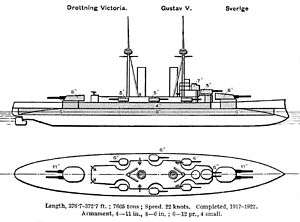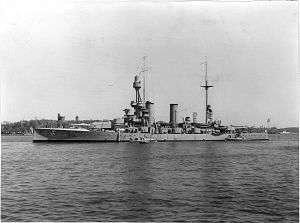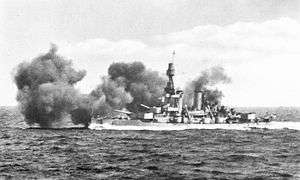Sverige-class coastal defence ship
 A 1912 depiction of Sverige | |
| Class overview | |
|---|---|
| Name: | Sverige class |
| Builders: |
|
| Operators: |
|
| Preceded by: | Oscar II |
| Built: | 1912–1922 |
| In commission: | 1917–1957 |
| Completed: | 3 |
| Scrapped: | 3 |
| General characteristics | |
| Type: | Coastal defence ship |
| Displacement: |
|
| Length: |
|
| Beam: | 18.6 m (61 ft) |
| Draught: | 6.2 m (20 ft) |
| Propulsion: |
|
| Speed: |
|
| Complement: |
|
| Armament: |
|
| Armour: |
|
The Sverige-class coastal defence ships were a class of coastal defence ships that, at the time of introduction, were the largest ships to serve in the Swedish Navy. Their design was completely new and was influenced by the ships of the time. Their armament consisted of four 283 mm (11 in)/45 cal. Bofors guns in two turrets and eight 152 mm (6 in) Bofors guns in one double and six single turrets. During the Second World War they were the backbone of the Swedish Navy.
Specifications




Displacement
- HSwMS Sverige
- 6,852 tons standard;
- 7,516 tons full load,
- 7,080 tons - Jane's Fighting Ships 1938
- Sverige reconstructed 1932-1933
- HSwMS Drottning Victoria and HSwMS Gustav V:
- 7,125 tons standard
- 7,633 tons full load
- 7,120 tons - Drottning Victoria - Jane's Fighting Ships 1938
- 7,275 tons - Gustav V - Jane's Fighting Ships 1938
- Gustav V reconstructed 1929-1930, modernized 1937
- Drottning Victoria reconstructed 1935
Dimensions
- Length: 120 m (390 ft) - Sverige
- Length: 121.6 m (399 ft) - Drottning Victoria and Gustav V
- Breadth: 18.6 m (61 ft)
- Draught: 6.3 m (21 ft) - Sverige
- Draught: 6.2 m (20 ft) - Drottning Victoria and Gustav V
Armour
- Main belt: 200 mm (7.9 in) between barbettes, then 100 mm (3.9 in) and 60 mm (2.4 in) sections
- Upper belt: 100 mm (3.9 in) from just behind fore barbette to aft barbette
- Main turret: 200 mm (7.9 in) front, 100 mm (3.9 in) side, 50 mm (2.0 in) roof
- Main barbettes: 150 mm (5.9 in)
- Secondary turrets: 125 mm (4.9 in)
- Secondary barbettes: 100 mm (3.9 in)
- Conning Tower: 175 mm (6.9 in)
- Deck: 45 to 30 mm (1.8 to 1.2 in)
Machinery
- 4 shafts; Curtis direct-coupled turbines 20,000 SHP in Sverige; 12 Yarrow-type coal-fired boilers
- 2 shafts; Westinghouse geared turbines manufactured by Motala Company in Gustaf V and Drottning Victoria 22,000 SHP; 12 Yarrow-type coal-fired boilers
- All ships were upgraded to oil-fired boilers in the 1930s (In Gustaf V and Drottning Victoria it was, however, for strategic reasons decided to keep the ability to burn coal to secure their ability to operate on alternative fuel if the Swedish oil supply was cut off)
Armament
As built
- 4 × 283 mm (11 in) 45 cal. Bofors guns (2 twin turrets), load in 17 seconds, rated as cramped, dividing partition between guns
- 8 × 152 mm (6 in) 50 cal. Bofors QF guns (1 twin turret superfiring over the forward 283 mm battery, and 6 single turrets, 3 on each beam)
- 4 × 75 mm (3 in) Bofors AA cannons mounted forward of the rear 283 mm battery
- 2 × 57 mm (2.2 in) short-barreled Bofors cannons (6 pdr.)
- 9 × 6.5 mm (0.26 in) MG
- 2 × 457 mm (18.0 in) torpedo tubes
Modernizations
- The underwater torpedo tubes were removed, and the underwater torpedo room was converted into an artillery central to serve the installation of modern range meters and fire control equipment for heavy, secondary and AA-gunnery
- All small gunnery and 2 152 mm (6 in) guns were removed and replaced with modern Bofors 75mm, 40mm and 20mm anti aircraft gunnery.
- The range of the 283 mm (11 in) main-artillery was upgraded by new ammunition.
- 450 complement after reconstruction
Appearance
All three ships looked similar until reconstruction. Gustav V had funnels trunked into one and the upper works modified heavily. Sverige had the fore funnel trunked back away from the superstructure which was modified, and kept the second funnel, making the ships very different in appearance between the main turrets. Gustav V also had her forward superfiring twin 152 mm (6 in) turret removed, and replaced with a platform for gyro-stabilized AA artillery ( 4 x 40 mm bofors) while Sverige and Drottning Victoria had their midship single 152 mm (6 in) guns removed and replaced with gyro-stabilized AA platforms (Bofors 40 mm double mountings)
Ships
Three of these ships were built:
- Sverige was ordered in 1912 and completed in 1917, built by Götaverken Gothenborg. She was paid for by public subscription as the Swedish people's gift to the country.
- Drottning Victoria (Queen Victoria) was ordered in 1915 and completed in 1921, built by Götaverken Gothenborg. She had an improved design, with an icebreaking bow and different machinery.
- Gustav V was ordered in 1915 and completed in 1922, built by Kockums shipyard in Malmö. She had the same improved design as Drottning Victoria.
A fourth ship was considered but not built due to economic difficulties.
The ships were modernised in the 1930s with oil-fired boilers replacing the old coal-fired boilers, removal of underwater torpedo equipment, new anti-aircraft guns and fire control equipment.
Tactical doctrine and effectiveness

The Sverige-class ships differed in several ways from the classical coastal Defence ship; at first by heavier armament as well as better speed and armour, but still small enough to operate and hide in the archipelagos and shallow waters . But the main difference was to be noted in their tactical doctrine and operations. Unlike other coastal defence ships, the Sverige class formed the core of a traditional open-sea battle group (Coastal Fleet), operating with cruisers, destroyers, torpedo boats and air reconnaissance like traditional battleship tactics of the time. This "mini battle group" had no intention, nor need, to challenge the superpowers in blue sea battles but to operate as defensive shield to aggression challenging Swedish interests and territory. Based on the doctrine that you need a battle group to challenge a battle group, the Coastal Fleet presented a considerable obstacle to anything smaller than a full-size battleship or battlecruiser, but in a tactical situation where full-size battleships would have very limited operational space exposing them to submarines, fast torpedo crafts, land based dive-bombers and minefields. It has been suggested that the Sverige-class ships were one reason why Germany did not invade Sweden during World War II. This speculation appeared in Warship Magazine 1992 Edition, in the article "The Sverige Class Coastal Defence Ships", by Daniel G Harris. The claim was supported in the postwar publication of German tactical orders, when tactical scenarios regarding attacking Sweden was published. Pointing out the problems of maintaining an army in Sweden without sea superiority, and underlining lack of available suitable units to challenge the Swedish navy (“Stations for battle”, Insulander/Olsson, 2001)
References
- Hore, Peter; Ireland, Bernard (2013). The Illustrated Encyclopedia of Battleships & Cruisers. Anness. ISBN 1 78019 292 4.
- "HMS Gustav V". laststandonzombieisland.com. 2013. Retrieved 10 Jul 2016.
- "Navypedia Swedish Navy Capital Ships". Ivan Gogin. 2015. Retrieved 10 Jul 2016.
External links
| Wikimedia Commons has media related to Sverige class coastal defence ships. |